Maybe you don’t care about food trucks.
Maybe you eat leftovers at your desk, or frequent the restaurant next to your office.
But if you care about people having access to good, reasonably priced food, and the ability to open and operate a safe, responsible and successful business, the food-truck fight happening across the country should matter to you.
Three cities – Los Angeles, Chicago and Washington, D.C. – exemplify the varying degrees of government rules that dictate what you can eat and who can serve it to you.
At the worst end of the spectrum is Chicago.
Chicago works unabashedly to make it difficult for food trucks to exist within city limits.
Since the 1980s, the status of the city’s food-truck regulations has been a point of serious contention between food-truck owners and the restaurateurs and politicians who oppose their existence.
In 1986, a city ordinance that made it illegal for food carts and food trucks to operate within 200 feet of a restaurant was overturned in a Cook County Circuit Court.
“The law made no sense,” said Lou Elovitz, the attorney who argued successfully in favor of Thunderbird Catering Co., the plaintiff fought against the 200-foot limit. “Why would a restaurant be entitled to keep a competitor away? Because they pay rent? That makes no sense. People have a right to buy food anywhere. We’re talking about food, sustenance – people must eat.”
But again in 1991, it became illegal for food trucks to do business within 200 feet of a restaurant (except for those serving construction workers, which received a special exemption from the city).
Not surprisingly, as of July 2012, there were only about 120 food trucks on the road in Chicago, only 50 of which constitute modern “gourmet” food trucks; the rest generally served construction sites, according to the Washington, D.C.-based Institute for Justice. In 2012, the city passed revisions to the food-truck laws that allowed food-truck owners to cook on board (previously they had been banned from preparing food onboard their vehicles), but also added language requiring food trucks to have a GPS tracker on at all times.
Find the entire article at The Huffington Post <here>
The 200-foot rule still stands today. And those backing the city’s restaurants, including Tom Tunney, the 44th Ward Alderman and owner of the Ann Sather chain of restaurants, make no secret that the main driver behind the city’s oppressive rules is to protect established businesses.
“One of the major issues is spacing from brick-and-mortar restaurants,” Tunney told the Chicago Sun-Times in 2011. “We’ve got work to do. We need to hear from all sides. We need to make sure we protect … restaurants and foster a trend that, I think, is gonna be here for a while.”
On the other side of the country, Los Angeles and its residents experience an entirely different food-truck culture.
According to Bloomberg writer Stephanie Armour, Los Angeles had more than 2,400 food trucks as of 2012. These vendors line the streets in neighborhoods all over town, offering customers everything from Korean tacos to lobster rolls to wood-oven pizza.
L.A.’s food truck rules ensure that mobile vendors operate in a way that preserves public safety and don’t include wording that would restrict these businesses’ freedoms – but only because state law prohibits the city from going any further.




